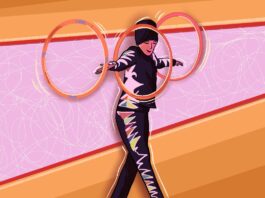The Carleton University Art Gallery (CUAG) opened its doors to its latest themed exhibitions, called Open Space Labs.
According to CUAG’s website, the Open Space Labs involve pushing the conventional barriers of art exhibitions by producing and reproducing art in different forms, allowing for a flow of creative artistry.
The first exhibition, Grounding I: States of Gender by artist Gita Hashemi, is a durational performance that began on Jan. 31 and will run until Feb. 11.
Hashemi’s exhibition portrays the life story of an Iranian woman, Zahra, and her struggles experiencing womanhood and imprisonment in a gendered and sexualized body.
CUAG held artist talks with Hashemi and Anna Khimasia, the curator of the exhibition, on Feb. 7. They discussed Hashemi’s unconventional storytelling performance through the art of calligraphy.
The exhibition space includes calligraphic work in Farsi on large-sized, wall-mounted canvasses, next to the spread of canvasses on the floor where Hashemi continually works on her project. Two cameras are mounted directly above the entire floor, one that captures photos during Hashemi’s writing process for the potential production of a time lapse video at the end of the project, and another that captures a livestream for CUAG’s website.
Hashemi, a Toronto-based Iranian artist, said she works on multi-platform projects that generally combine and draw inspiration from different mediums. She said she prefers the use of digital media to showcase her work because of the freedom it provides, as there is no censorship or mediation involved in the process.
During the conversation, Hashemi said her project aims to bring gender back into mainstream conversation, and address stereotypical and problematic Western notions of Middle Eastern women as oppressed.
“We need to bring back gender—not as a side thing, but as central part of the conversation. Not as an appendix, an addendum, an afterthought—it needs to be foremost in our conversation,” Hashemi said.
Combining the geographical and political implications of Iran, and the gendered implications of being female, Hashemi said her project heavily revolves around the experience of being an Iranian woman and asserting agency in today’s world.
Hashemi also included the issues of body image and sexuality in the project. She said she also wanted to raise awareness in the Iranian community regarding language and its symbolism of confining sexuality.
Among the black-lettered calligraphy, Hashemi included red-coloured letters every now and then, and said they served to emphasize words in Farsi that are often deemed dirty, including references to the female genitalia. She also used the red lettering for her responses to Zahra’s stories.
Khimasia said transmission was an important facet of the project, from the transmission between Zahra and Hashemi, between Farsi and English, and between her and Hashemi.
Khimasia added the project was incredibly intimate.
“When I first started reading it, I felt like I was invading, if you will, as if I had opened somebody’s diary because it was so personal. It really felt like someone had written it without having an audience in mind,” Khimasia said.
– Photo by Justin Samanski




